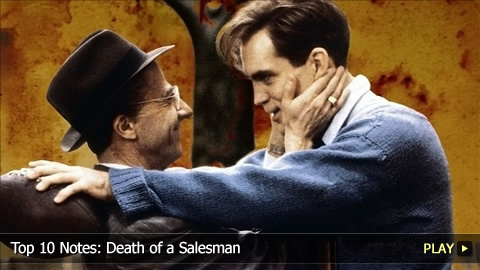Top 10 Notes: Death of a Salesman

#10: About the Author
Born in 1915 in Harlem, New York, Arthur Miller worked to help his family following the Wall Street Crash of 1929. He started writing plays during university and soon found Broadway success. He then branched out into screenplays and married actress Marilyn Monroe. He died in 2005.
#9: Influences and Inspirations
Miller was influenced to write the play by an uncle who was a salesman. As a tragedy criticizing the country’s focus on capitalism and materialism, “Death of a Salesman” also tackles the difficulties of attaining the American dream. It alternates between the past and present using a stream of consciousness technique and flashbacks.
#8: Settings and Era
Meant as a critique of 1940s American society, the play is mostly set in Brooklyn, New York. This is where Willy Loman’s house is located, in between larger, overwhelming apartment buildings.
#7: Plot
While there’s no narrator, “Death of a Salesman” is told mainly from protagonist Willy Loman’s point of view. The play follows his life as a 60-plus salesman who pursues the American dream even though he’s not that great at his job. Loman believes his son Biff should also become a salesman. Loman tries to escape reality by recalling his memories, leaning on others for support and doing things he shouldn’t. After Biff and his brother Happy leave their father at a restaurant, their mother Linda gets involved. Though more fighting ensues, they eventually reconcile. Loman then sacrifices himself in the hopes his son will use the insurance money to follow in his footsteps.
#6: Willy Loman
As a 63-year-old father of two sons, Loman is the title salesman. After a recent car accident, he’s become insecure and suffers from depression. Despite this, he’s ambitious and believes in attaining material wealth in line with the American dream. Unfortunately, he doesn’t have a very good grip on reality and thinks he’s a lot better at his job than he really is. When he realizes his son Biff doesn’t want to follow his same career path, Willy becomes driven by his own “willy”-ness: he resorts to losing himself in the past, having an affair with another woman, and taking his own life. His suicide seems to be a metaphorical moral struggle in which he finally understands that what he’s selling is himself - after all the highways, trains, and appointments, he ends up worth more dead than alive.
#5: Biff Loman
As the eldest son, Biff is the child that Willy projects his hopes and dreams on. Unfortunately, he gave up working hard at school after he discovered his father cheating on his mother with another woman. He goes from job to job because he keeps getting caught stealing and despite wanting his father’s approval, he doesn’t want to be a salesman. Biff just wants to be accepted for who he is. Though he despises his father and what he represents, he still cares about him. He knows they’re living a lie and eventually manages to confront this.
#4: Linda and Happy Loman
As Willy’s naïve and loyal wife, Linda shares her husband’s belief in material success as the key to happiness but is also clueless when it comes to his many lies and secrets. She’s a complex character who’s always there to keep her family together. As Willy and Linda’s youngest son, Happy wants to be loved and respected by his parents, even though his father seems to favor Biff. This makes him strive for a better job in the business world. He represents the happy American dream and is a rather shallow character who doesn’t progress much in the novel.
#3: Values and Themes
One of the play’s main themes is the pursuit of the American dream and a focus on material gain and success in the hopes that this will bring respect, freedom and happiness. It also explores lying versus truth, dreams versus reality and betrayal versus trust.
#2: Modern Popularity
Following its 1949 Broadway debut, “Death of a Salesman” became a critical and commercial success and positioned Miller as one of the twentieth century’s most important American playwrights.
#1: Adaptations
Aside from Broadway productions and multiple revivals, Miller’s play has been adapted for the screen multiple times. This includes the Oscar-nominated 1951 version and multiple TV movies.
Do you agree with our list? What’s your favorite piece of “Death of a Salesman” trivia? With new top 10s published daily, be sure to subscribe to WatchMojo.com.